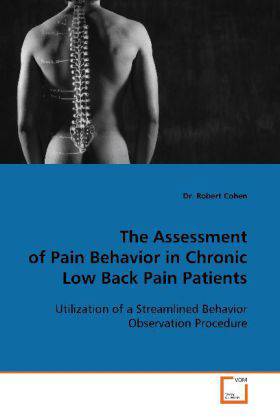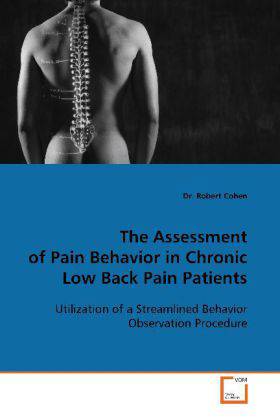
- Afhalen na 1 uur in een winkel met voorraad
- Gratis thuislevering in België vanaf € 30
- Ruim aanbod met 7 miljoen producten
- Afhalen na 1 uur in een winkel met voorraad
- Gratis thuislevering in België vanaf € 30
- Ruim aanbod met 7 miljoen producten
Zoeken
The Assessment of Pain Behavior in Chronic Low Back Pain Patients
Utilization of a Streamlined Behavior Observation Procedure
Robert Cohen
Paperback | Engels
€ 48,45
+ 96 punten
Omschrijving
Observations of pain behavior have distinct
advantages over self-report measures of pain. This
is especially critical in a chronic lower back pain
population where self-report of pain is unusually
high. The goal of the current study was to
investigate whether a streamlined behavior
observation adapted from Keefe and Block s (1982) 10-
minute observation is effective in identifying
somatic amplification in a sample of Chronic Low
Back Pain (CLBP) sufferers. We examined the
relationship between a 4-minute behavior observation
and the Somatic Amplification Rating Scale (SARS), a
physiological exam measuring incongruent physical
symptoms. Somatic amplification describes the
tendency to report physical symptoms that are out of
proportion to medical findings. Ninety-seven
participants were recruited to take part in a study
that examined levels of somatic amplification,
affective distress, and frequency of pain behaviors.
advantages over self-report measures of pain. This
is especially critical in a chronic lower back pain
population where self-report of pain is unusually
high. The goal of the current study was to
investigate whether a streamlined behavior
observation adapted from Keefe and Block s (1982) 10-
minute observation is effective in identifying
somatic amplification in a sample of Chronic Low
Back Pain (CLBP) sufferers. We examined the
relationship between a 4-minute behavior observation
and the Somatic Amplification Rating Scale (SARS), a
physiological exam measuring incongruent physical
symptoms. Somatic amplification describes the
tendency to report physical symptoms that are out of
proportion to medical findings. Ninety-seven
participants were recruited to take part in a study
that examined levels of somatic amplification,
affective distress, and frequency of pain behaviors.
Specificaties
Betrokkenen
- Auteur(s):
- Uitgeverij:
Inhoud
- Aantal bladzijden:
- 56
- Taal:
- Engels
Eigenschappen
- Productcode (EAN):
- 9783639119800
- Uitvoering:
- Paperback
- Afmetingen:
- 220

Alleen bij Standaard Boekhandel
+ 96 punten op je klantenkaart van Standaard Boekhandel
Beoordelingen
We publiceren alleen reviews die voldoen aan de voorwaarden voor reviews. Bekijk onze voorwaarden voor reviews.











